|
Creativity Reigns in
Mexican Nacimientos
by Bob Brooke
Throughout the world at Christmas, many people set up a nativity
scene. Most common are the 14-piece sets found in all Christmas
departments of discount stores. But to the Mexicans, the nativity
scene, called a nacimiento, has become much more. It’s a
display of handmade and bought figures placed in elaborate scenery
which has become an extension of their faith in the celebration of
the birth of Jesus.
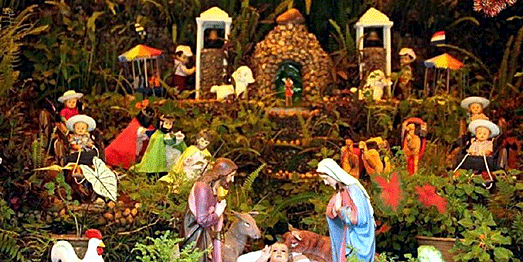
St. Francis of Assissi created the first nativity scene in Greccio,
Italy, in 1223 using a real stable, barnyard animals and local persons.
Thus began a tradition that has transcended cultures and historic time
periods.
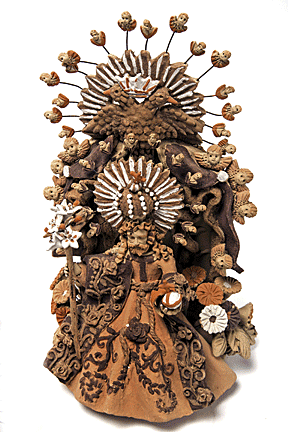 Father
Pedro de Gante began the celebration of Christmas in Mexico with the
Misa de Gallo, or the Mass of the Rooster six years after the arrival of
the Spaniards. Held at midnight, it became popular with the
newly-converted Indians. Father
Pedro de Gante began the celebration of Christmas in Mexico with the
Misa de Gallo, or the Mass of the Rooster six years after the arrival of
the Spaniards. Held at midnight, it became popular with the
newly-converted Indians.
To help bridge the gap between the Aztec religion and Catholicism, the
Spanish missionaries timed their Christmas celebrations to coincide with
those for the Aztec God of the Sun Huitzilopochtli, pleading for his
return and praising both the Sun and his virgin mother goddess. Father
Diego de Soria added displays of live nacimientos to the
Christmas festivities. He and other Spanish priests taught the Mexicans
to carve nativity figures. And as happened with colonial church
decoration in Mexico, they used traditional folk art in their designs.
Nacimientos, which used to be called Belens, or Bethlehems,
well into the last century, have become the main decorations in local
homes, businesses and churches, in Mexico. People use painted paper,
sand, moss, sawdust, and multi-tiered bases to create hills, deserts,
rivers and lakes. Whole villages magically appear on tabletops, and each
year, the creators add more characters and scenes, beginning around
December 14th and displayed until February 2.
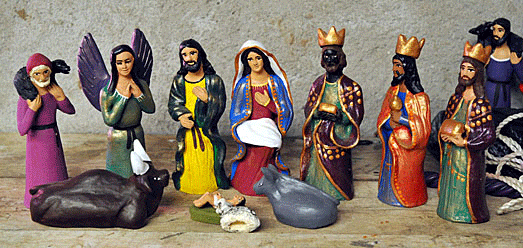
The focus of the nacimiento is a stable where plaster or clay
figures of the Holy Family find shelter. An angel, Los Reyes Magos (the
Magi), an ox and a donkey, shepherds and their sheep, and assorted other
people and livestock populate the scene. Sometimes, the forces of evil,
represented by a serpent and a grotesque Lucifer, lurk in the shadows.
The figures may be simply positioned in a bed of heno, or Spanish
moss, or scattered throughout an elaborate landscape.
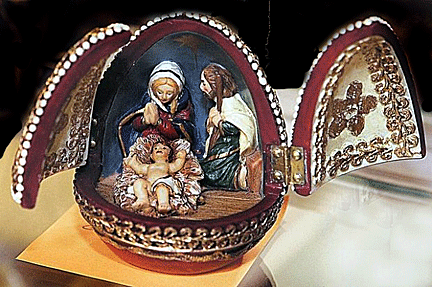 A
typical nacimiento shows Jesus in a crib, with the Virgin Mary
and Joseph at his side. Inside the portal, which can take the form of a
cave, a stone house or a cabin, there are several animals–horses,
burros, oxen, cows and sheep–surrounding the holy family. The star they
followed to Bethlehem always crowns the nacimiento, giving it
light and color. So far, this sounds like any other nativity scene
through the world. But that’s where the similarity ends. A
typical nacimiento shows Jesus in a crib, with the Virgin Mary
and Joseph at his side. Inside the portal, which can take the form of a
cave, a stone house or a cabin, there are several animals–horses,
burros, oxen, cows and sheep–surrounding the holy family. The star they
followed to Bethlehem always crowns the nacimiento, giving it
light and color. So far, this sounds like any other nativity scene
through the world. But that’s where the similarity ends.
Often, Mexicans devote an entire room of their homes to arrange and
display the hundreds of pieces that make up the miniature village
surrounding the stable where Mary and Joseph focus on the empty manger,
awaiting the birth of the Christ child. Besides the main figures, there
may be farmers plowing their fields or milking cows, women making
tortillas, mothers nursing infants, merchants selling pottery or
vegetables, and an assortment of shepherds shown doing chores throughout
the day. Many families incorporate waterfalls, mountains or deserts.
Some add new features or figures each year, searching for new ways to
illustrate daily life.
Other nacimientos have a Biblical focus, re-creating the Garden
of Eden, Herod’s soldiers destroying the children, Jesus at the well
with Mary Magdalene, his mother Mary at the base of the cross, and other
biblical scenes. Historical figures like the pharoahs of Egypt and St.
John the Baptist may also be included in the scene.
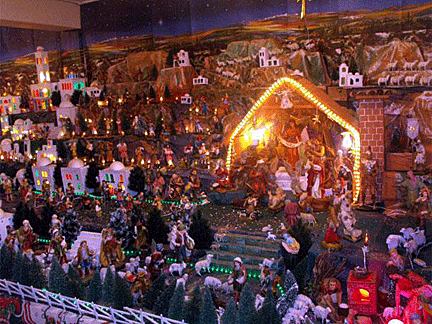 The
largest nacimientos occupy an entire room, often near the front
of the house for convenient viewing by neighbors and other visitors. To
create the basic landscape, a homeowner begins by painting paper in
earth tones, or papel roca, which is then draped over tables, taped onto
boxes, crushed and shaped to form a multi-leveled, natural looking
terrain that frequently includes a series of hills and valleys, a
cellophane waterfall, a mirror pond, artificial trees, cacti, palm
trees, and little houses set to produce an entire village. Next, an
assortment of natural mosses and colored sawdust may be spread out as
ground cover before the addition of strings of Christmas lights and a
variety of human and animal figures. But the scene isn’t completed until
the newborn Baby Jesus is finally laid in the manger on Christmas Eve. The
largest nacimientos occupy an entire room, often near the front
of the house for convenient viewing by neighbors and other visitors. To
create the basic landscape, a homeowner begins by painting paper in
earth tones, or papel roca, which is then draped over tables, taped onto
boxes, crushed and shaped to form a multi-leveled, natural looking
terrain that frequently includes a series of hills and valleys, a
cellophane waterfall, a mirror pond, artificial trees, cacti, palm
trees, and little houses set to produce an entire village. Next, an
assortment of natural mosses and colored sawdust may be spread out as
ground cover before the addition of strings of Christmas lights and a
variety of human and animal figures. But the scene isn’t completed until
the newborn Baby Jesus is finally laid in the manger on Christmas Eve.
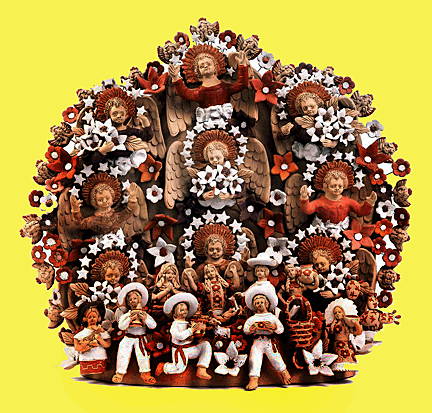 In
addition, nacimientos often have purely Mexican traditions, such
as the rooster crowing to announce the birth of the child, fish in the
river–from the Mexican Christmas carol Los Peces en el Rio– the devil
lurking in his cave to tempt the shepherds from their journey, and the
Egyptians camping with their tents and pyramids. The result is a
representation of a complete Mexican village, with vendors selling
fruits and vegetables from their carts, children playing, dancers and
musicians, pigs roasting on spits, even women making tortillas. In
addition, nacimientos often have purely Mexican traditions, such
as the rooster crowing to announce the birth of the child, fish in the
river–from the Mexican Christmas carol Los Peces en el Rio– the devil
lurking in his cave to tempt the shepherds from their journey, and the
Egyptians camping with their tents and pyramids. The result is a
representation of a complete Mexican village, with vendors selling
fruits and vegetables from their carts, children playing, dancers and
musicians, pigs roasting on spits, even women making tortillas.
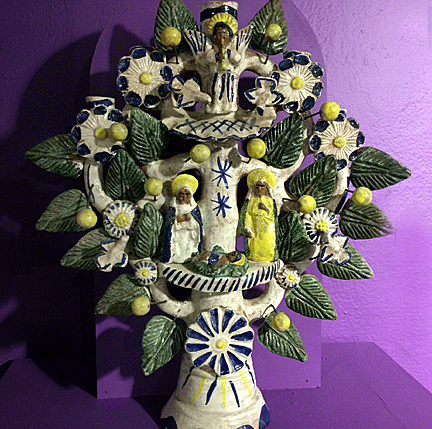 Sometimes,
there are four-inch figures of Mary and Joseph and a nearly life-size
Christ child. Tradition says that on January 6, during the fiesta to
honor the arrival of the Three Kings at the manger, a special
ring-shaped bread called the Rosca should be served. Baked into the
bread is one or more small plastic figures of the Christ child. The
guests who find these images in their serving of bread become the
godparents of the Christ child. It’s then their responsibility to host a
party on February 2, El Dia de Candlelaria or the Day of Purification,
the final celebration of a Christmas holiday which began on December 3
with the beginning of the 10-day Feast of the Virgin of Guadalupe. In
many villages, women dress the Child from the nacimiento in a
long white gown and bonnet, place him on a small chair and take him to
the church to be blessed on February 2. And in some regions of Mexico,
the Christ child’s appointed godparents rock the baby to sleep before
placing the figure in the manger during a special Christmas Eve party
the following year. Sometimes,
there are four-inch figures of Mary and Joseph and a nearly life-size
Christ child. Tradition says that on January 6, during the fiesta to
honor the arrival of the Three Kings at the manger, a special
ring-shaped bread called the Rosca should be served. Baked into the
bread is one or more small plastic figures of the Christ child. The
guests who find these images in their serving of bread become the
godparents of the Christ child. It’s then their responsibility to host a
party on February 2, El Dia de Candlelaria or the Day of Purification,
the final celebration of a Christmas holiday which began on December 3
with the beginning of the 10-day Feast of the Virgin of Guadalupe. In
many villages, women dress the Child from the nacimiento in a
long white gown and bonnet, place him on a small chair and take him to
the church to be blessed on February 2. And in some regions of Mexico,
the Christ child’s appointed godparents rock the baby to sleep before
placing the figure in the manger during a special Christmas Eve party
the following year.
<
Back to More Antique Spotlights
Next Article >
|
